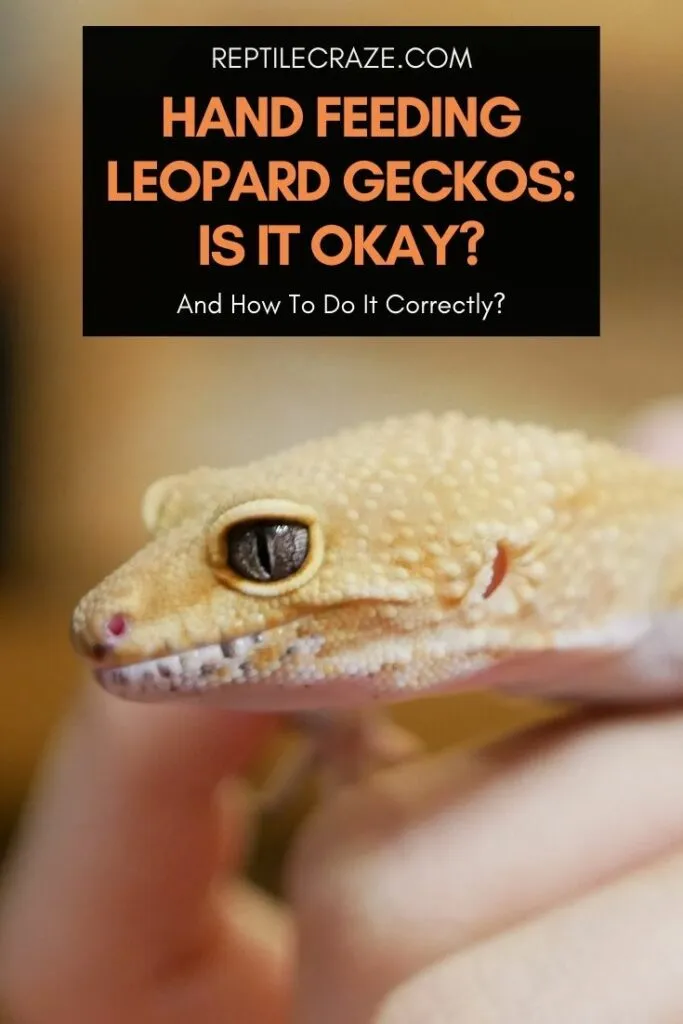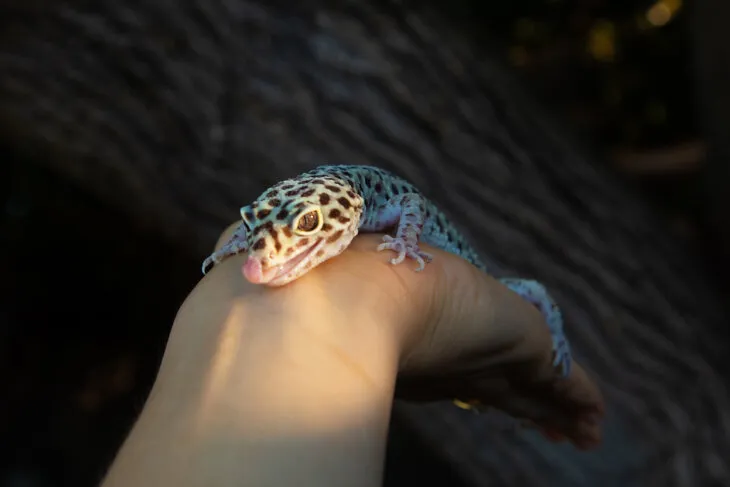
There are many ways to offer
Hand-feeding your Leopard Gecko is a positive way to build a trust relationship and work on handling. It is also necessary to aid Leopard Geckos who are sick or blind. But, hand-feeding is not as enriching as allowing your Leopard Gecko to hunt and deprives them of exercise and natural behavior.
Let’s learn more about why you might choose to hand feed, and how to do it well.
Table of Contents
Reasons To Hand-Feed Your Leopard Gecko
There are times when hand-feeding your Leopard Gecko is a very positive method. Any time that you want to associate your presence with good things, you can use hand-feeding to create that connection.
Also, being hand-fed is easy for your Leopard Gecko. So, at times when they need a little extra help eating, you can hand-feed them.
Note: If you want to hand-feed your leo because it is not eating, you should read this article. It shows you 21 reasons why your leopard gecko may have stopped eating.
Hand Feed Your Leopard Gecko To Build Trust
When you have a new Leopard Gecko, or your Leopard Gecko seems to be a bit nervous, you can use hand-feeding to help them associate you with positive things. Your Leopard Gecko will be able to make the connection between you and receiving
When you are working toward having your Leopard Gecko trust you, you may need to work in small steps. Try placing the insect down in front of them at first, and withdrawing your hand.
You could also use longer tongs so that your Leopard Gecko doesn’t need to come too close. Over time, you can get progressively closer, until your Leopard Gecko is eating out of your hand.
Hand Feed Your Leopard Gecko If It Is Blind
Sometimes Leopard Geckos can go blind. This could be the result of diseases, injuries, or infections. Once they go blind, they cannot hunt for themselves.
Hand-feeding is a great way to assist your blind Leopard Gecko to eat. To do this, we recommend using tongs instead of your fingers, as your Leopard Gecko can’t see what they are going to bite.
Hand Feed Your Leopard Gecko If It Is Unwell
Sometimes, your Leopard Gecko may go through a phase of not eating, or feeling very lethargic. If your Leopard Gecko is acting unusually, it is best to seek the advice of a vet.
If your Leopard Gecko does not feel able to hunt or is not showing interest in
Reasons Not To Hand-Feed Your Leopard Gecko
Hand-feeding is not always the best option. Hand-feeding can cause some issues in the long run, if it is overused. We recommend that you allow your Leopard Gecko to hunt for most of its
Hand-Feeding Takes Away The Chance To Hunt
Good animal husbandry relies on encouraging natural behavior and recreating a natural environment. Allowing your Leopard Gecko to hunt is a great way to do this.
When you hand-feed, you take away the opportunity for your Leopard Gecko to express natural behavior. Encouraging hunting will keep your Leopard Gecko mentally alert and enrich their lives.
Hand-Feeding Can Make Your Leopard Gecko Dependant
If you hand-feed every meal to your Leopard Gecko, they may become unwilling to hunt and catch
While you do want to hand-feed some
For young Leopard Geckos, you may want to introduce new foods by hand at first, especially if they are reluctant. But, once they have got a taste for the new insect, encourage them to stalk and chase it, until they are capable of feeding themselves.

Hand-Feeding Doesn’t Encourage Exercise
Leopard Geckos in captivity have very little reason to exercise. In the wild, they may need to travel around at dawn and dusk, searching for insects. Once they find the insects, they need to put effort into stalking and catching them.
But, in captivity, their space is more limited. There is no need to explore or search for
The little exercise they do get is when live insects are placed in their enclosure or feeding box. When you hand-feed, you take away this opportunity to move about and get some exercise.
Hand-Feeding Could Lead To Injuries
Hand-feeding does carry a risk of injury for both you and your Leopard Gecko. Your Leopard Gecko might bite you by mistake. This is unlikely to hurt but it isn’t pleasant. Even small cuts carry a risk of infection.
Also, your Leopard Gecko might injure his mouth, especially if you use tongs. Metal tongs are much stronger than your Leopard Gecko’s soft mouth tissues, and he could bite them hard in his excitement to grab an insect.
How To Hand-Feed Your Leopard Gecko
Before hand-feeding your Leopard Gecko, it is important to thoroughly wash your hands. If you are using tongs, these should be washed and sterilized.
Offer your Leopard Gecko just one insect at a time. Ensure that you dust your insects in calcium powder if it is a scheduled day for supplements. Hold the insect near the end, to reduce the chance of your finger or the tongs getting bitten.
Don’t squeeze the insect too hard. Leopard Geckos like prey that is moving, so you don’t want to kill it. Hold out the insect, about 2 inches from your Leopard Gecko’s face, if he is sighted.
You want to give your pet the opportunity to see the prey and move toward it voluntarily.
When your Leopard Gecko focuses his eyes on the prey and goes still, he is about to spring and bite. Prepare yourself so that you stay calm and steady.
You don’t want to get startled and jump! That will ruin the trust exercise and possibly hurt you or your pet.
If your Leopard Gecko is blind, he will not be able to see the prey. Gently hold it at the side of his mouth so that he can feel the insect moving there.
Beware that your Leopard Gecko may not give a sign that he will snap before he tries to grab the insect.
Tip: Also read our article on signs your leopard gecko likes you!
How Hand-Feeding Is Different From Force-Feeding
The primary difference between hand-feeding and force-feeding is that when you hand-feed, you offer
When you force-feed, you might physically open the mouth of your Leopard Gecko and put
During force-feeding, you are also gently restraining your Leopard Gecko. For hand-feeding, your Leopard Gecko should not be restrained. Find out more about when to force-feed a Leopard Gecko in our detailed guide.
- Enchi Ball Python: A Unique and Stunning Morph of Python regius - March 27, 2025
- Emerald Tree Monitor: The Enigmatic Green Guardian of the Rainforest - March 26, 2025
- The Egyptian Cobra (Naja haje): A Fascinating Serpent - March 25, 2025
